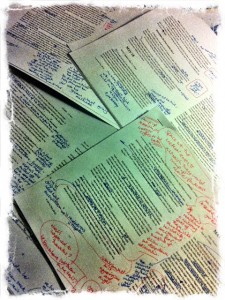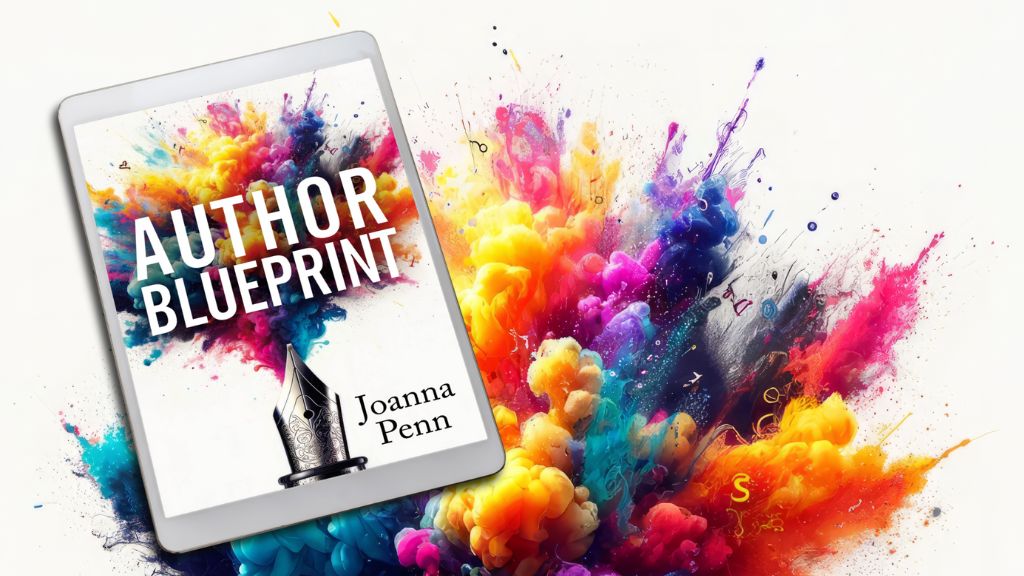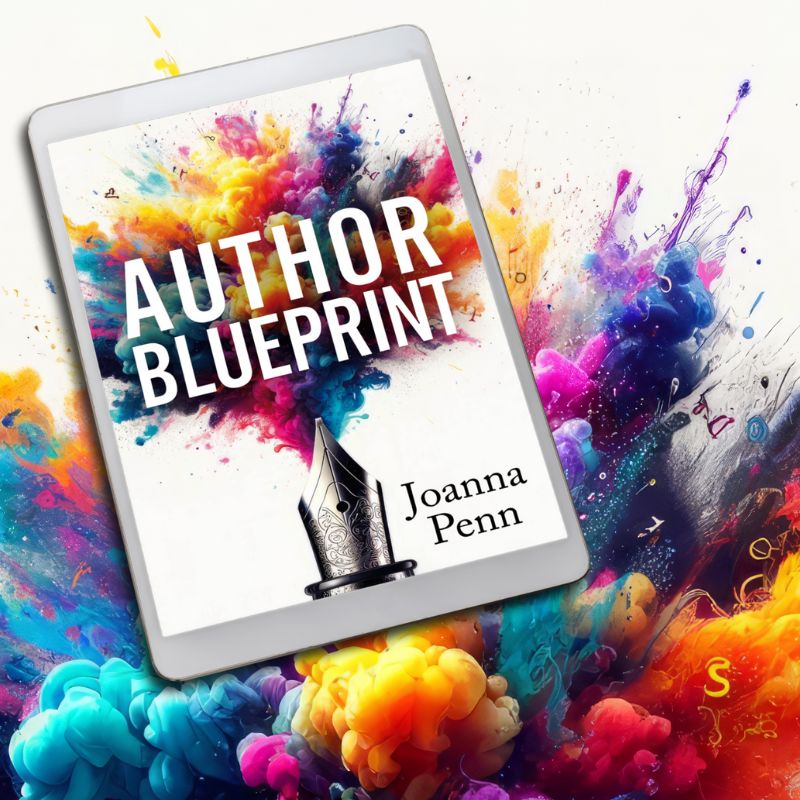OLD POST ALERT! This is an older post and although you might find some useful tips, any technical or publishing information is likely to be out of date. Please click on Start Here on the menu bar above to find links to my most useful articles, videos and podcast. Thanks and happy writing! – Joanna Penn
Investing in professional editing (and cover design) is generally my #1 tip when it comes to self-publishing.
 The more eyes on your work before it goes out there, the better it will be. In this article, Sarah Kolb-Williams explains how to improve your own self-editing before you engage a professional.
The more eyes on your work before it goes out there, the better it will be. In this article, Sarah Kolb-Williams explains how to improve your own self-editing before you engage a professional.
Before you scan this post looking for a sanction to skip editing, let me save you some time:
A self-edit is not a replacement for a professional copyedit
Authors are simply too close to their own writing to see it objectively.
Even with your attention dialed up to 11, there’s always the possibility that you moved a section and forgot to erase the original. And after reading that section 7,213 times, the 7,214th can slip right by you like Obi-Wan at a costume party.
Your own mind can Jedi-mind-trick you. This post is not the excuse you’re looking for.
But if you like getting your hands dirty . . .
Your book has to meet readers’ expectations, both in broader developmental issues like story and content, and in the smaller details. And there are steps you can take to get your manuscript into the best shape possible, both organizationally and typographically.
Some of my suggestions are developmental; others deal with common sentence-level issues that I’ve encountered. You certainly don’t have to take every step—that’s what editors are for—but here are 10 editing secrets that can help you fake a pro edit before an editor enters the picture.
1. Put the manuscript away
Separating yourself from your manuscript and coming back to it with fresh eyes enables you to finally see what’s on the page, rather than superimposing what was in your mind when you wrote it.
In nonfiction, you might catch yourself introducing terms without defining them or scattering topics around your book; in fiction, you may notice that your living, breathing characters don’t have quite the vibrancy you thought you’d given them, or that your storyline rambles.
In any case, you’ll be better able to catch those sneaky copied-and-pasted sections if you can go through the book as a reader, forgetting what it felt like to actually write it.
2. Make an outline
It doesn’t matter if you write romance, science fiction, or how-to guides—an outline can and will help you avoid catastrophe.
You don’t have to use Scrivener or make one of those Roman numeral things you learned to make in school. The important part is writing down the main ideas in each section of the book, then looking carefully at how they relate (or don’t) to the ideas around them.
I like to write on small pieces of paper, then rearrange them on my desk to see how they best fit; adopt whatever method works for you. But without an outline, you run the risk of forgetting where you’re going, and then forgetting to clean up after it.
You want readers to reach the end of the book with a feeling of satisfaction, not niggling questions about whatever happened to the gorgeous babe from the stables who dropped out of the cast somewhere in chapter 3, or why chapter 6 refers to future subject matter that doesn’t actually appear in the book.
3. Make a style sheet
If you don’t already keep a style sheet as you draft, that’s fine—many authors don’t—but a style sheet is an important part of editorial review. Editing is not just about correctness; it’s also about consistency, and a good style sheet ensures that a document is internally consistent.
Divide a sheet of paper into a grid and alphabetize the cells, or simply open a new Word document, and bam—you have yourself a style sheet!
Now, carefully go through the whole manuscript, word by word. As you come across them, list out:
- Proper nouns (characters, cities, organizations, etc.), both real and made up
- Anything you had to look up
The scope of that second point is the difference between a tight style sheet and a floppy one (and, for that matter, between an experienced and inexperienced copyeditor). If you don’t know to look something up, you won’t write it down—and you may not notice that you treat the issue differently the next time it comes up.
4. Read aloud
You may think this sounds silly, but I assure you, it is not. I may not be able to tell instantly that an author has read a manuscript aloud—but I can absolutely tell you when an author has not.
Even if you’re reading to an empty room, reading aloud makes you slow down so your eyes can’t gloss over anything, and it forces you to listen to the cadence of your writing. I’m all for long, eloquent, beautifully written constructions (see #7), but if you find yourself pausing three times to breathe before you get through a sentence, consider breaking it into smaller, more manageable pieces.
5. Keep an eye out for compound words
This is a copyeditor’s secret: train yourself to be hyperaware of each individual word, and know that just because spell-checker doesn’t flag something doesn’t mean you’re in the clear. Any time two separate words are crunched together, ask yourself: hyphen, space, or closed?
An example: Is it “collarbone,” “collar bone,” or “collar-bone”? Look it up, and add it to your style sheet so you don’t have to look it up again.

6. Untangle your dashes
There are three kinds of dashes: hyphen ( – ), en dash ( – ), and em dash ( — ). Short, medium, long. But let’s forget about the middle dash for the moment; you’re much more likely to need one of the two extremes.
Chicago devotes many pages to dashes, but here’s the quick and dirty: Hyphens join words, while em dashes join clauses.
My name, “Kolb-Williams,” gets a hyphen—but I used an em dash to separate this clause.
Some authors use hyphens as a catch-all dash-but as you can see here, the hyphen confounds. There’s no such thing as a “dash-but,” and it takes a few runs through the previous sentence to catch the syntax.
(Incidentally, en dashes can stand for “to” in ranges: the Seattle–Vancouver line, 8:00–12:30. For more exciting punctuation, see CMOS.)
7. Semicolon-“however”-comma
Ahh, the semicolon. It seems to be going the way of the dinosaur. Personally, I miss this “outdated” writing style in which semicolons are frequently employed to join two separate sentences together in unity, if they feel sufficiently attracted to each other to make the commitment.
One way the semicolon continues to stand proudly is in the “however” construction, however more than one excellent writer has stumbled over it.
See what I did there? Here’s the right way:
A semicolon feeds my nostalgia; however, in this case, it is a necessary punctuation.
Now you know! Go forth and punctuate. (You could also break this into two sentences.)
8. Move the awkward abbreviations
Abbreviations like “etc.,” “e.g.,” and “i.e.” have their uses, but I believe (and Chicago agrees with me) that these awkward-looking words should not appear in regular text.
Instead, keep those abbreviations set off in parenthesis and footnotes—places that function as an aside—leaving the main text free for those words we can hear spoken in our minds (like “and so on,” “for example,” and “in other words”).
9. Write out your numbers
Digits tend to stick out aesthetically. For example, soften your gaze and look gently at your screen as you scan the following sentences:
She collected 4 carrots, 5 apples, and 11 monkeys.
He produced twelve pens, one paperclip, and three notebooks.
If one of them doesn’t stick out over the other to you, it’s only because you’re determined to prove me wrong. (Probably because of a deep-seated attachment to AP style. It’s okay. We can still be friends.)
Sticking with the idea of words we can hear in our minds, spell out more numbers than you might think. Readers don’t hear digits, they hear words. (I’m not sure, but I like to think this is why Chicago’s convention is to spell out most numbers from 1 to 100.)
There are exceptions. Spelling out long and complex numbers is patently ridiculous (“1,298,525” would require way too many words), and decimals and fractions are a different story entirely. But for your nice, plain numbers, your twos and fifties and eleven hundreds, use words.
10. Share it with beta readers
No, this isn’t “self-editing” per se—but it’s more important than everything else on this list combined.
Even if you have no desire to do any further critical thinking about your book whatsoever, give it to beta readers and let them do the work for you. Collect feedback from a handful of readers, and whenever two or three of them suggest the same thing, seriously consider doing that thing.
True, your beta readers might not care about your dashes, semicolons, or compound words. That’s fine; your copyeditor can clean that up. But they’ll be able to give you a new reader’s perspective, and that feedback will be worth its weight in gold.
What are your questions about editing, or do you have editing tips to share? Please add them in the comments below and join the conversation.
 Sarah Kolb-Williams is a writer, editor, and serial comma enthusiast from the Twin Cities.
Sarah Kolb-Williams is a writer, editor, and serial comma enthusiast from the Twin Cities.
Find her at kolbwilliams.com or on Twitter (@skolbwilliams).


Very nice post, but it’s deep-seated, not deep-seeded (see #9). I differ slightly on dashes too.
It certainly is — my brain did one thing while my fingers did another! (That self-editing thing, you know…) Good catch!
We all have our little “things,” don’t we? Like the comment left by Persnickety (great name, by the way)–I would have put a comma before “too.”
I’ll bet one or both of you will catch a few editorial mishaps in my comment, too. That’s why I love editing. It’s never done until you give up. LOL
“It’s never done until you give up” applies perfectly to so much about writing — I’m going to save that one somewhere. 🙂
Exceedingly helpful post. Also on my self-editing list is to remove words I use too often (in my case, the word perhaps) and words I tend to use incorrectly (almost always the word that.)
When I am editing others, I make a point of removing “every” quotation mark that is “not” indicating dialogue. (See how the quotation marks read as sarcasm?)
Thanks for the share.
Nicole, thanks for the comment! I remove quite a lot of “that” and “of” from my own writing the second time through, along with “very” and “some” and similar words with fuzzy meaning.
And please tell me you’ve seen this: http://www.unnecessaryquotes.com/ 🙂
Style sheets, em dashes, semicolons: my three lil amigos!
Is it weird that I just pictured Steve Martin and Chevy Chase as bits of punctuation? 🙂
Thanks for the great post. I like the idea of creating a style-sheet. I’m definitely going to do that with my current edit. One trick I also use is to search for was and see where I can make the verbs stronger. It helps me to focus on one problem at a time.
Lily, I don’t know how I lived before I learned to make a style sheet. Such a lifesaver. And I think going through and replacing “was” with juicier verbs is about is about my favorite part of rewrites! Everything sounds so much snappier.
Thanks for the comment!
Don’t take out all the blemishes! Was is perfectly acceptable in some sentences. ‘It was a hot morning, again, hotter than it was yesterday and tomorrow will be hotter.’
A book needs to live and we all use ‘was’ in our everyday, live conversation so don’t cut them all out.
I am a great fan of using the Find function. My list includes, had, suddenly, then, and now.
Agree, Robin, ‘was’ is fine. Just like any other word…don’t over use it. We only use ‘had’ when setting a past perfect situation; never use now and use suddenly maybe once in the entire book.
On another note…never heard it called ‘Style sheet’. We use the same thing, but call it a ‘Bone Pile’ like in writing screen plays. Use what ever works for you.
Ken, I am absolutely never thinking of it as a style sheet again. Thank you for giving me my new favorite term!
Really. I love it.
You’re welcome, ma’am. I like the way everybody on this thread shares ideas. Good stuff.
No, you’re absolutely right — not all of them. But it’s a good find-and-replace shortcut to possible weak spots!
I find the last suggestion a tiny bit depressing, as for me it’s akin to reading the suggestion, “Write a bestselling novel.” I’ve tried and tried and tried to find beta readers for my novel. I had fourteen people volunteer to read it, and only one of them actually did. I spent an entire year of my life just trying and failing to get those fourteen people to read my novel. So it would be nice if that part of the process weren’t taken for granted.
Mishell, I’m sorry I didn’t see this until now! Have you tried an online writers’ group? There are lots of options for group or even one-on-one beta reading, if you’re willing to read someone else’s novel in exchange. This way you can find other authors to help you!
Thought of something — have you tried Ladies Who Critique (http://ladieswhocritique.com/)? Joanna featured founder Laura Pepper Wu last year (http://www.thecreativepenn.com/2012/09/16/get-amazon-book-reviews/), which is how I heard about the website — you should be able to find a critique partner that way. Good luck!
I think it’s great to follow these lines of advice in getting your novel as close to perfect as you can. However, there’s something to be said about a professional edit.
I couldn’t imagine letting my books go to publish without my editor looking at it first. In my first book, she had so many tips and suggestions that allowed my book to read that much better. I feel like I’ve learned a lot just from working with her, and have carried her advice into the most recent novel I wrote. And it doesn’t have to be expensive to hire an editor. Mine cost less than $500. I know, that can still be steep for a struggling author (I have yet to make up that difference in sales!). But I’m looking at long-term goals here. Several books from now, readers will be looking up my older books, and I want them to be read just as well as my newer books read when I do start making significant money on them.
To afford an editor, it just takes some strategic saving (or sell some stuff!). It’s that one expense that is worth the cost, and can actually benefit you in the long run.
Crissi, I agree with you 100 percent. Editing is an investment, but a crucial one. Thanks for your thoughts!
Great advice, all around! Thanks for sharing. I’m going to keep this one handy for quick reference. I especially like the style-guide idea. I’m writing a sci-fi/police procedural, and I can’t seem to keep some of my jargon straight that I’ve invented. 🙂
Liberty, style sheets are SO helpful to keep track of made-up sci-fi terms! I like to get riled up at Star Trek for not keeping one from episode to episode — lots of weird variants on jargon. 🙂
#4 is great advice. I felt kind of weird when I first starting reading aloud, but it does slow down the eyes, which helps us notice mistakes that otherwise would have gotten through.
Great advice, but missing one crucial item I think (it’s implied but not spelt out).
Print It Out.
I do all of my writing and early editing in scrivener, then later editing in open office. Once I’m reasonably happy with that it’s time to print it out (in courier font with line and a half spacing). You’ll be amazed at the things you completely missed on the screen which seem to scream out once they are on the page.
Simon, absolutely! I often print my articles to review them, or even review them on my Kindle — just looking at something in a different format can help a ton.
I’m afraid to say that there are some editors who are little more than con artists. They have a fancy webpage and lots of glowing testimonials, mostly or completely false and charge at or about the normal rates for their work. Sadly, they have no professional qualification or experience so make sure you get a name from someone you trust, not simply picking a name at random.
I recently reviewed a book that had been published on Kindle a week previously, after being edited twice and found nineteen typo or punctuation errors and three errors in continuity of fact. (different locations and in one instance, a different name!)
Spend your money wisely. Use as many beta readers as you can. get your friends and relations to read it out loud to you. Share the dialogue and make sure it sounds realistic. Search your manuscript for words like; then, now, suddenly, was, did, and and!
When you have spent a loooong time doing all that, then find an editor who knows what he or she is doing.
All fantastic advice, Robin!